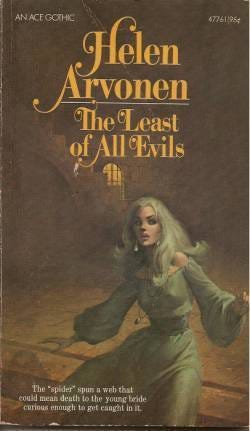Adventure Stories with Passive Protagonists
"The Love Story is - for women - success, failure, education, and the only adventure, all in one."
“Somebody’s Trying to Kill Me and I Think It’s My Husband” is the brilliantly titled and brilliantly written article published by Joanna Russ in 1973.
Although she’s writing about “the modern gothic,” a genre which was quite popular at the time and seemingly absent from the current zeitgeist, her analysis and observations are eerily and inconveniently still relevant.
I’m going to spend a few Substack dispatches unpacking this one, so hold on to your flowy peignoir and passively buckle in for an adventure.
Part 1: Context! Laying the foundation of this mysterious Manse
Part 2 and so on: ??? It’s a mystery, just like that room your husband tells you not to go in and the answer to “what are women allowed to do under patriarchy?”
And Then Sometime Later: Something something about how the vestiges of this genre are still present in the current romance genre.
Modern Gothics: Middle Class Ladies Love Them!
According to Russ:
Modern Gothics…are read by middle-class women or women with middle-class aspirations…
…and according to Terry Carr, an editor she interviewed who worked in the genre, and who had presumably cracked the code of “what middle-class women feel”:
The basic appeal is to women who marry guys and then begin to discover that their husbands are strangers…so there’s a simultaneous attraction/repulsion, love/fear going on.
Most of the “pure” Gothics tend to have a handsome, magnetic suitor or husband who may or may not be a lunatic and/or murderer…it remained for U.S. women to discover they were frightened of their husbands.
Essentially, Russ’s analysis continues to explore this idea, that the formulaic Modern Gothic mirrors the repetitive attempts by the reader to understand how the thing she’s been told and believes should be her foremost desire —a man— and her path for attaining happiness — marriage to him — is also a confusing, unfulfilling nightmare.
This Article is an Adventure with an Active Protagonist
Russ’s article is hard to describe — it’s full of delightfully scathing and astute observations, and while built on a foundation of textual analysis and includes a smattering of theory, it feels somehow too energized by the author’s personality to be shelved as “scholarly research.”
I mean that as the highest compliment (and I like reading scholarly research).
(Charmingly, it also includes an illustration of a woman fleeing TO a gothic tower in the original Journal of Popular Culture publication.)
It’s a delight to read something thoughtful and provoking that deviates from the proper understanding of how arguments must be made in order to be valid, almost as if conveying the feeling of the research is just as important as the ideas.
For example:
At her most enterprising a Heroine may…recklessly toss about pieces of information that expose her to being drowned or pushed off a glacier.
And:
[quoting from a text] “Nick had raced through France for this-for me!” (Gabriella)
The birds had better sing like mad, or even a Gothic Heroine might wonder whether “this” and “me” are always identical.
I mean, why not have fun with it?
The Cis Het White Elephant In The Room
A lot of the romance scholarship I’ve read that speaks to broad patterns in romance texts and its readers centers the analysis on middle class cis white women, who tend to identify as heterosexual or be in heterosexual relationships.
Russ’s essay/article is no exception (although the “cis” and “white” are silent, as they damningly almost always are.)
That focus aligns with the target market that traditional publishing explicitly caters to (pointedly using present tense here…), and while there have always been readers of romance who don’t match that buyer persona demographic, it’s also true that many other readers will opt out explicitly because the books didn’t resonate with them…because the books aren’t for them.
That’s not to say that there’s no scholarship about groups of texts/readers outside of the cis/het/white/middle class “target market.” There is exciting romance research on readers and writers who have traditionally been marginalized in the industry: Julie Moody-Freeman’s work on the Black Romance Podcast and Lucy Hargrave’s work on queer romance history are two that spring to mind.
That said, I think it’s fair to say that a lot of romance scholarship talks about middle class cis het white women because it is their anxieties and cultural norms that are most often being centered and explored on the pages.
Up Next: Unpacking Passivity and Being the Object of Men’s Desire
"Men's desire is a testimony to my personal, individual worth."
Stray closing thought:
I was also thinking about heroines in romances who aren’t allowed to want, and who stand in contrast to the active, grasping other women, or “double” as Russ writes about, because this came up in my conversation with Helena Greer in a recent double-header series of episodes discussing North and South.
Check them out here:
Sources:
Russ, J. (1973), Somebody's Trying to Kill Me and I Think It's My Husband: The Modern Gothic. The Journal of Popular Culture, 6: 666-691. https://doi.org/10.1111/j.0022-3840.1973.00666.x







